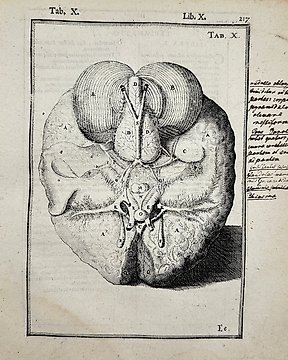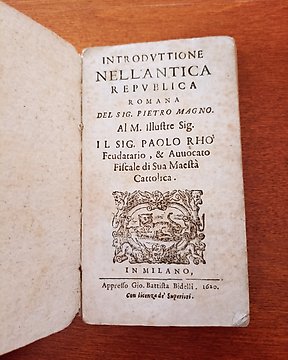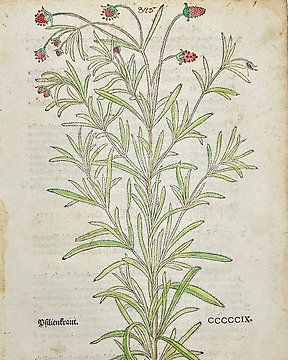Wonderful item perfectly described
Se oversettelseRobertus Valturius - De re militari - 1534
Nr. 85336259






(MILITARIA; ENGINEERING, MACHINES; ILLUSTRATED) Robertus VALTURIUS (1405-1475)
En tibi lector Robertum Valturium ad illustrem heroa Sigismundum Pandulphum Malatestam Ariminensium regem, De Re Militari Libris XII multò emaculatius, ac picturis, quae plurima in eo sunt, elegantioribus expressum, quam cum Veronae inter initia artis chalcographicae, Anno M.cccclxxxiiii invulgaretur. Parisiis, apud Christianum Wechelum, sub insigni scuti Basiliensis. 1534.
§ Small folio (310 x 206); [12], 383, [1] pp. Woodcut printer’s mark on title and verso of last leaf, 84 large/full-page woodcuts illustrations. Later vellum, gilt title-piece on spine. Unimportant stain on lower margin, never affecting the text, title page probably from another copy, a fine item on large and crisp paper.
Second issue of the famous Wechel edition, the first edition of Valturius published in France, and to the previous issue of 1532 but for the date. The work was first published in Verona in 1472 by Johannes Nicolai de Verona and twice by Boninus in 1483, both in the original Latin and in the Italian translation. A French translation appeared only in 1555. The author, Roberto Valturio (1413-1483) was born in Rimini, he was a military engineer and a technical advisor of Sigismondo Malatesta, Duke of Rimini, for whom the present treatise was written. The work, possibly written between 1446 and 1455, circulated for some years in several manuscripts before being printed. “Written when gunpowder’s powerful influence on military technique was already a century old, yet ancient methods of siege-warfare were still practiced, the text of the book is on the whole rather backward-looking and contains no revolutionary military principles ... The historical importance of the De re militari lies in the fact that it is the first book printed with illustrations of a technical or scientific character depicting the progressive engineering ideas of the author’s own time. The ... woodcuts illustrate the equipment for the military and naval engineer; they include revolving gun turrets, platforms and ladders for sieges, paddlewheels, a diver’s suit, a lifebelt, something resembling a tank, pontoon and other bridges, a completely closed boat which could be half-submerged etc.” (PMM). “There are numerous finely executed woodcuts in firm outline, comprising 97 subjects: adapted from the 1483 edition, but reversed as regards right and left, each design thus reverting to its original position as in the 1472 edition. The subjects embrace the following: military engines such as ballistae and catapults, rams, cannon, grenades, scaling ladders, water-raising machines, a clepsydra or water-clock (with 17 hours marked on dial), bridges and rafts, paddle-boats, those in section etc. ... many of the ideas being most ingenious ... The artist responsible for these cuts is evidently Mercurius Jollat ... The quality of these cuts seems to be much higher than in other known works of this artist.” (Fairfax Murray). The work is a war encyclopedia, linked to a long tradition in which the classical models of Frontinus and Vegetius are grafted onto fifteenth-century military treatises. Unlike its predecessors De re militari aims to provide a complete inventory of the characteristics, qualities and education necessary for a good leader, effectively configuring itself as an example of speculum Principis. The intent of the treatise - divided into twelve books - is mainly eulogical: Sigismondo Malatesta, to whom the work is dedicated, is seen as the ideal prince, the only modern captain worthy of being mentioned alongside the great leaders of the past (Chisena). There are sections on military arithmetics and geometry, explaining how to calculate heights and distances by shadows or by means of instruments, on astronomy and, in the eleventh chapter concerning nautical art, an exhaustive discussion on meteorology and nautical astronomy. A list of the classical works mentioned and an introduction on the history of warfare are also present. The famous woodcut representing a swimmer (on page 317) is criticized by Thomas as not conducive to any form of swimming.
Ref: PMM 10, (for the 1472 edition); FAIRFAX MURRAY French, 560; ANNA GABRIELLA CHISENA Valturio, Roberto In: Dizionario Biografico degli Italiani; THOMAS Swimming p. 88; CICOGNARA 681 (for the 1472 edition); RICCARDI I/2, 581. 1 (erroneously giving an edition of 1533); Kat. Berl. 1765 (edition 1532); COCKLE 501 (note); HONEYMAN 3024 (edition 1532); MORTIMER 536; ADAMS V-225.
(MILITARIA; ENGINEERING, MACHINES; ILLUSTRATED) Robertus VALTURIUS (1405-1475)
En tibi lector Robertum Valturium ad illustrem heroa Sigismundum Pandulphum Malatestam Ariminensium regem, De Re Militari Libris XII multò emaculatius, ac picturis, quae plurima in eo sunt, elegantioribus expressum, quam cum Veronae inter initia artis chalcographicae, Anno M.cccclxxxiiii invulgaretur. Parisiis, apud Christianum Wechelum, sub insigni scuti Basiliensis. 1534.
§ Small folio (310 x 206); [12], 383, [1] pp. Woodcut printer’s mark on title and verso of last leaf, 84 large/full-page woodcuts illustrations. Later vellum, gilt title-piece on spine. Unimportant stain on lower margin, never affecting the text, title page probably from another copy, a fine item on large and crisp paper.
Second issue of the famous Wechel edition, the first edition of Valturius published in France, and to the previous issue of 1532 but for the date. The work was first published in Verona in 1472 by Johannes Nicolai de Verona and twice by Boninus in 1483, both in the original Latin and in the Italian translation. A French translation appeared only in 1555. The author, Roberto Valturio (1413-1483) was born in Rimini, he was a military engineer and a technical advisor of Sigismondo Malatesta, Duke of Rimini, for whom the present treatise was written. The work, possibly written between 1446 and 1455, circulated for some years in several manuscripts before being printed. “Written when gunpowder’s powerful influence on military technique was already a century old, yet ancient methods of siege-warfare were still practiced, the text of the book is on the whole rather backward-looking and contains no revolutionary military principles ... The historical importance of the De re militari lies in the fact that it is the first book printed with illustrations of a technical or scientific character depicting the progressive engineering ideas of the author’s own time. The ... woodcuts illustrate the equipment for the military and naval engineer; they include revolving gun turrets, platforms and ladders for sieges, paddlewheels, a diver’s suit, a lifebelt, something resembling a tank, pontoon and other bridges, a completely closed boat which could be half-submerged etc.” (PMM). “There are numerous finely executed woodcuts in firm outline, comprising 97 subjects: adapted from the 1483 edition, but reversed as regards right and left, each design thus reverting to its original position as in the 1472 edition. The subjects embrace the following: military engines such as ballistae and catapults, rams, cannon, grenades, scaling ladders, water-raising machines, a clepsydra or water-clock (with 17 hours marked on dial), bridges and rafts, paddle-boats, those in section etc. ... many of the ideas being most ingenious ... The artist responsible for these cuts is evidently Mercurius Jollat ... The quality of these cuts seems to be much higher than in other known works of this artist.” (Fairfax Murray). The work is a war encyclopedia, linked to a long tradition in which the classical models of Frontinus and Vegetius are grafted onto fifteenth-century military treatises. Unlike its predecessors De re militari aims to provide a complete inventory of the characteristics, qualities and education necessary for a good leader, effectively configuring itself as an example of speculum Principis. The intent of the treatise - divided into twelve books - is mainly eulogical: Sigismondo Malatesta, to whom the work is dedicated, is seen as the ideal prince, the only modern captain worthy of being mentioned alongside the great leaders of the past (Chisena). There are sections on military arithmetics and geometry, explaining how to calculate heights and distances by shadows or by means of instruments, on astronomy and, in the eleventh chapter concerning nautical art, an exhaustive discussion on meteorology and nautical astronomy. A list of the classical works mentioned and an introduction on the history of warfare are also present. The famous woodcut representing a swimmer (on page 317) is criticized by Thomas as not conducive to any form of swimming.
Ref: PMM 10, (for the 1472 edition); FAIRFAX MURRAY French, 560; ANNA GABRIELLA CHISENA Valturio, Roberto In: Dizionario Biografico degli Italiani; THOMAS Swimming p. 88; CICOGNARA 681 (for the 1472 edition); RICCARDI I/2, 581. 1 (erroneously giving an edition of 1533); Kat. Berl. 1765 (edition 1532); COCKLE 501 (note); HONEYMAN 3024 (edition 1532); MORTIMER 536; ADAMS V-225.
- 4
- 1
- 0
Very citified
Se oversettelseTutto bene, grazie.
Se oversettelseNão era precisa, nem completa, a descrição feita.
Se oversettelsePerfetto
Se oversettelse- 4
- 1
- 0
Wonderful item perfectly described
Se oversettelse








